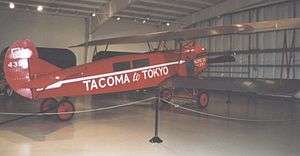Fokker C.IV
| C.IV | |
|---|---|
 | |
| Fokker C.IVA modified with cabin for passengers for planned non-stop flight Tacoma-Tokyo. Preserved airworthy in Owls Head Museum, Maine | |
| Role | Two-seat reconnaissance aircraft |
| Manufacturer | Fokker |
| First flight | 1923 |
| Introduction | 1924 |
| Primary users | Dutch Army Air Corps United States Army Air Service USSR |
| Number built | 159 |
|
| |
The Fokker C.IV was a 1920s Dutch two-seat reconnaissance aircraft designed and built by Fokker.
Design and development
The C.IV was developed from the earlier C.I but it was a larger and more robust aircraft. The C.IV was designed as a reconnaissance biplane with a fixed tailwheel landing gear and was originally powered by the Napier Lion piston engine. It had a wider fuselage and wider track of the cross-axle landing gear than the C.I.
Operational history
Examples of the C.IV were delivered to both the Dutch Army Air Corps (30 aircraft) and the Dutch East Indies Army (10 aircraft). It was also exported; the USSR bought 55 aircraft and the United States Army Air Service acquired eight. Twenty aircraft were licensed built in Spain by the Talleres Loring company for the Spanish Army's Aeronáutica Militar. After service as reconnaissance machines the aircraft were then operated as trainers into the 1930s.
The last flying example of a C.IV is a C.IVa with a Rolls-Royce Eagle VIII engine, preserved at the Owls Head Transportation Museum in Owls Head, Maine. It was used in a trans-Pacific attempt in the late 1920s or early 1930s. Pilots Bob Wark and Eddie Brown took out the seats in the passenger compartment and installed a large fuel tank. They also put a small cockpit just in front of the vertical stabilizer with a hand-powered fuel pump inside. In flight, the crew member sitting there would transfer fuel to the main tank in the wing, where it would be fed by gravity into the engine. In this trans-Pacific attempt they planned not to go straight across the Pacific but up the West Coast of North America to Alaska and down the chain of Aleutian Islands, proceeding down the Chinese coast to Tokyo. They took off from Tacoma, Washington and started to head north, but made it only about 100 miles of the way to Vancouver, British Columbia when the engine vapor locked and forced a landing in a field. They had to dump most of their fuel to bring down the weight in order to take off from the field. When they got back in the air, they started heading for nearby Ladner Field, Vancouver to top off the tanks, but they crashed upon landing and decided to give up. They loaded the C.IV onto a Ford AA flatbed truck and brought it back to Washington State. It ended up in Ephrata, Washington, where it was kept outdoors and was eventually badly burned in a grass fire. It sat until 1970, when one of the museum's trustees found it and restored it and donated it to the museum. It flies to this very day.[1]
Variants
- C.IV
- Production version with a 336 kW (450 hp) Napier Lion engine.
- C.IVA
- A reduced wing-span version (12.50 m/41 ft) and reduced takeoff weight. Built for the Dutch East Indies Army. powered by a Rolls-Royce Eagle VIII V-12 engine
- C.IVB
- As C.IV but using a Rolls-Royce Eagle or Liberty L-12 engine.
- C.IVC
- Long-range reconnaissance version with extended wingspan (14.27 m/46 ft).
- C.IV-W
- Extended wingspan as C.IVC and fitted with twin-floats and Napier Lion engine.
- C.IVH
- Special version for a flight between Amsterdam and Tokyo in 1924.
- XCO-4
- United States Army designation for three aircraft for evaluation.
- CO-4A
- United States Army designation for five production aircraft powered by 313 kW (420 hp) Liberty L-12A engine and fuselage extended by 24 cm (9½ in).
- AO-1
- United States Army designation for an artillery spotting version modified from one of the XCO-4s
Operators
- Dutch Army Aviation
Specifications (C.IV)
Data from The Illustrated Encyclopedia of Aircraft (Part Work 1982-1985), 1985, Orbis Publishing, Page 1858
General characteristics
- Crew: 2
- Length: 9.20 m (30 ft 2 in)
- Wingspan: 12.90 m (42 ft 3 in)
- Height: 3.40 m (11 ft 1 in)
- Wing area: 39.20 m2 (421.96 ft2)
- Empty weight: 1,450 kg (3,197 lb)
- Gross weight: 2,270 kg (5,004 lb)
- Powerplant: 1 × Napier Lion W-12 water-cooled piston engine, 336 kW (450 hp)
Performance
- Maximum speed: 214 km/h (133 mph)
- Range: 1,200 km (746 miles)
- Service ceiling: 5,500 m (18,045 ft)
Armament
- 1 or 2 × fixed forward-firing 7.7 mm (0.303 in) machine-guns, and twin cockpit-mounted guns
See also
- Aircraft of comparable role, configuration and era
- Related lists
References
| Wikimedia Commons has media related to Fokker C.IV. |
Notes
Bibliography
- Taylor, Michael J. H. (1989). Jane's Encyclopedia of Aviation. London: Studio Editions.
- Ogden, Bob (2007). Aviation Museums and Collections of North America. Air-Britain (Historians) Ltd. ISBN 0-85130-385-4.
- John Andrade, U.S.Military Aircraft Designations and Serials since 1909, Midland Counties Publications, 1979, ISBN 0-904597-22-9 (Pages 40 and 98)
- The Illustrated Encyclopedia of Aircraft (Part Work 1982-1985), 1985, Orbis Publishing, Page 1858